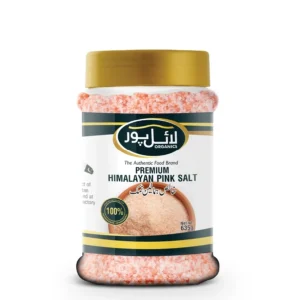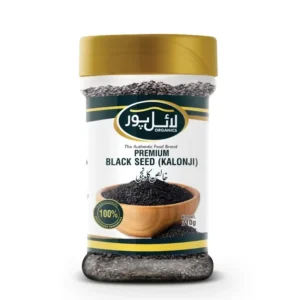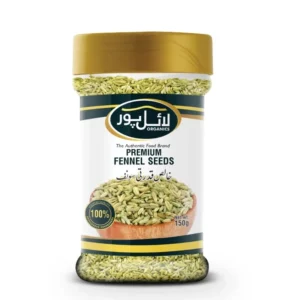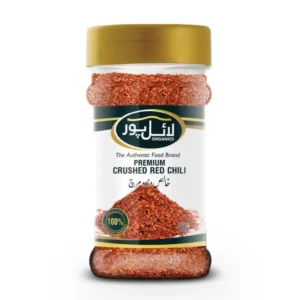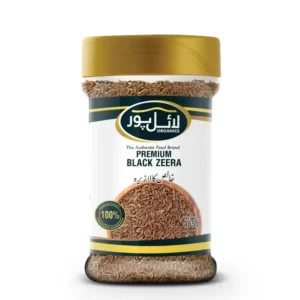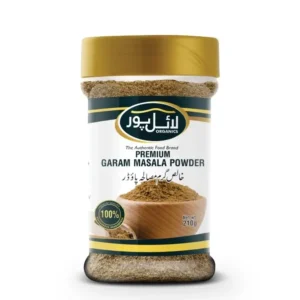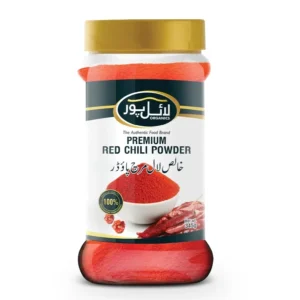Lyallpur Organics Premium Himalayan Pink Salt (Khalis Pink Himalayan Namak) – 100% Natural & Pure | Rich in Minerals | No Preservatives Added
Himalayan Pink Salt is a natural rock salt mined from the foothills of the Himalayas, primarily in Pakistan. The salt is famous for cooking and is prized for its health benefits and unique mineral content. Its vibrant color, ranging from soft pink to deep red, is due to the presence of iron oxide, and it contains over 80 trace minerals. Its unique flavor and texture improve various dishes, from gourmet cuisine to everyday meals.
History and Origin of Pink Salt
Himalayan Pink Salt has a rich history dating back millions of years. It is believed to have formed from the evaporation of ancient bodies of water around 250 million years ago during the Jurassic era. The salt deposits were buried under lava and then encased in snow and ice for millennia, preserving its purity and mineral content.
The salt was first discovered by Alexander the Great’s troops in 326 BC when they observed their horses licking the rocks. Over time, it became a valuable trade commodity, cherished for its unique taste and health benefits. Today, it is mined in the Khewra Salt Mine, one of Pakistan’s oldest and largest salt mines.
Himalayan Pink Salt is used in cooking, spa treatments, and decorative items like salt lamps, and it is known for its calming and relaxing feeling and potential health benefits.
The salt was first discovered by Alexander the Great’s troops in 326 BC when they observed their horses licking the rocks. Over time, it became a valuable trade commodity, cherished for its unique taste and health benefits. Today, it is mined in the Khewra Salt Mine, one of Pakistan’s oldest and largest salt mines.
Himalayan Pink Salt is used in cooking, spa treatments, and decorative items like salt lamps, and it is known for its calming and relaxing feeling and potential health benefits.
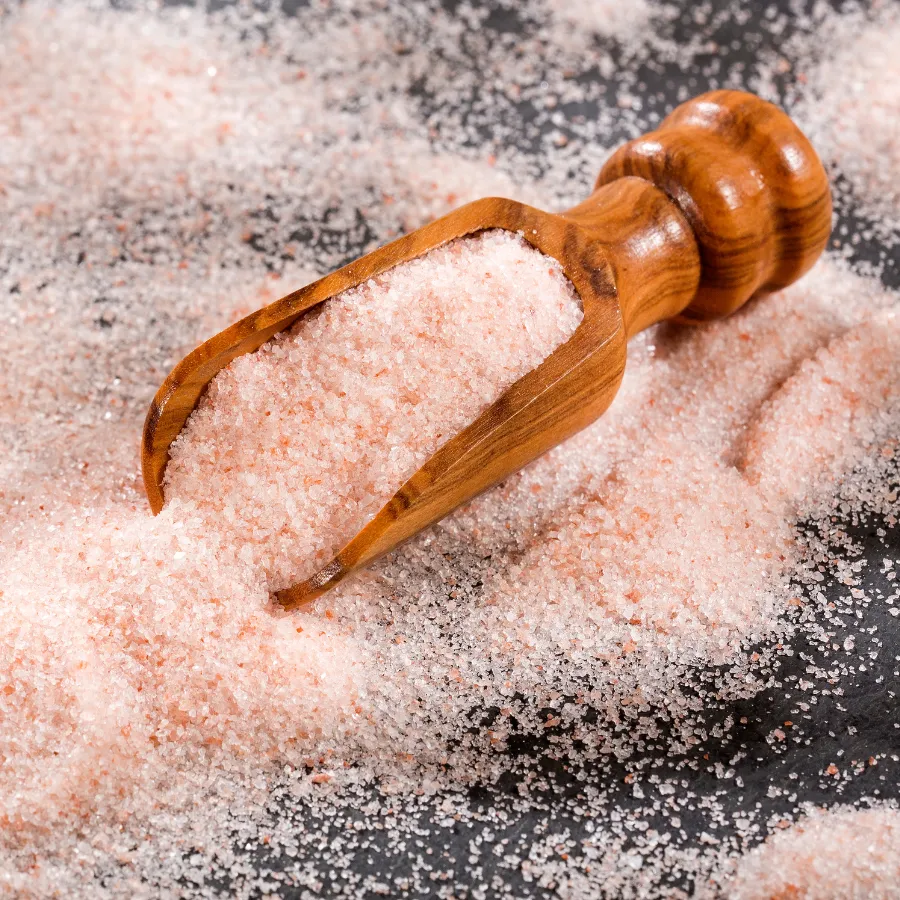
Top Selling Himalayn Pink Salt Product
Nutritional and Health Benefits of Khalis Pink Salt

- Rich in Minerals: It contains over 84 trace minerals, including potassium, magnesium, calcium, and iron.
- Lower Sodium Content: Compared to regular table salt, It has a lower sodium content per serving.
- Unrefined and Additive-Free: This Salt is unprocessed and does not contain additives or anti-caking agents.
- Balances Electrolytes: The minerals in the Salt help maintain electrolyte balance, which is crucial for muscle function and hydration.
- Improves Digestion: Consuming it can stimulate the production of hydrochloric acid in the stomach, aiding digestion and nutrient absorption.
- Promotes Hydration: Adding a pinch of Pink Salt to water can improve hydration by providing essential minerals that enhance water absorption in the body.
- Supports Respiratory Health: Inhaling air through practices like salt therapy or a salt inhaler improves respiratory conditions like asthma and bronchitis.
- Balances pH Levels: The minerals in this Salt can help balance the body’s pH levels, which is beneficial for overall health.
- Detoxifies the Body: Soaking in a bath with It can help remove toxins from the skin and tissues.
- Improves Skin Health: The minerals in Himalayan Pink Salt can improve skin health by promoting better hydration and pH balance.
Nutritional Composition of Pink Salt per 100g
Major Minerals
- Sodium: 36,800 mg
- Potassium: 3,200 mg
- Calcium: 1,600 mg
- Magnesium: 1,050 mg
- Iron: 38.9 mg
- Sulfur: 12.4 mg
- Phosphorus: 10.8 mg
- Iodine: 0.1 mg
- Zinc: 0.3 mg
- Selenium: 0.05 mg
- Copper: 0.1 mg
- Manganese: 0.27 mg
Trace Minerals
- Strontium
- Molybdenum
- Boron
- Fluoride
- Silicon
- Vanadium

Different Types of Himalayan Pink Salt

Extra Fine
Texture: Excellent powder.
Uses: Best for delicate seasoning and baking. Ideal for sprinkling on popcorn, using spice blends, and dissolving quickly in liquids.
Uses: Best for delicate seasoning and baking. Ideal for sprinkling on popcorn, using spice blends, and dissolving quickly in liquids.

Fine
Texture: Finely ground.
Uses: Suitable for everyday cooking, seasoning dishes, and baking. Easily dissolves in food and liquids.
Uses: Suitable for everyday cooking, seasoning dishes, and baking. Easily dissolves in food and liquids.

Medium Grain
Texture: Medium-sized crystals.
Uses: Perfect for seasoning meats, vegetables, and other dishes where a bit of texture is desired. It can be used in salt grinders.
Uses: Perfect for seasoning meats, vegetables, and other dishes where a bit of texture is desired. It can be used in salt grinders.

Coarse
Texture: Crystalline granules.
Uses: Ideal for salt grinders, providing a crunchy texture to dishes. Also used in bringing, curing, and preserving foods.
Uses: Ideal for salt grinders, providing a crunchy texture to dishes. Also used in bringing, curing, and preserving foods.

Chunks
Texture: Large, irregular chunks.
Uses: Suitable for salt lamps, salt baths, and salt therapy. It can also make homemade salt blocks for cooking or serving.
Uses: Suitable for salt lamps, salt baths, and salt therapy. It can also make homemade salt blocks for cooking or serving.
Different Types of Himalayan Pink Salt

Salt Blocks
Large, solid blocks of pink salt. Used for cooking and serving. Can be heated for grilling meats, seafood, and vegetables, or chilled for serving cold dishes like sushi and cheese. Adds a subtle saltiness to foods.

Salt Lamps
Chunks of salt carved into lamp shapes. Decorative pieces that also purport to purify the air and create a calming ambiance when lit. They are popular for their warm, soothing glow and potential health benefits.

Bath Salt
Coarse or fine grains of salt used for bathing. Added to bath water for a relaxing soak. Believed to draw out toxins, soothe sore muscles, and improve skin health. Commonly used in spa treatments and at-home relaxation routines.

Salt Scrubs
Fine grains mixed with oils or other ingredients. Used as exfoliants in skincare routines to remove dead skin cells and promote smoother, healthier skin. Often enriched with essential oils for added benefits.

Salt Inhalers
Small devices filled with salt crystals. For respiratory therapy. Inhaling salt-infused air is believed to help with respiratory issues like asthma, allergies, and sinus problems.

Culinary Accessories
Bowls, mortars, and other kitchen items made from Himalayan salt. Used for grinding spices and serving food, adding a unique touch and salt flavor to culinary presentations.
Cooking with Himalayan Pink Salt
The Salt elevates cooking from ordinary to extraordinary. Season meats, vegetables, and soups with its delicate, mineral-rich flavor. For an even more unique experience, try cooking food directly on a heated Himalayan salt block. The Salt gently infuses your food with a delicious taste.
Pakistani and Subcontinental Recipes
- Biryani: A fragrant rice dish with layers of spiced meat and rice. The Salt enhances the rich flavors of the spices and ingredients.
- Nihari: A slow-cooked stew of beef or lamb seasoned with spices and Pink Salt, creating an intensely flavorful dish.
- Chaat: A popular street food made with crispy fried dough, boiled potatoes, chickpeas, and tangy tamarind chutney. The Salt adds a unique taste to the chaat masala sprinkled on top.
- Raita: A cooling yogurt-based side dish often served with spicy meals. Mix Pink Salt with yogurt, cucumber, and mint for a refreshing accompaniment.
- Kebabs: Ground meat mixed with spices and Himalayan Pink Salt, then grilled or pan-fried. It helps to enhance the flavors and tenderize the meat.
- Pulao: A savory rice dish cooked with meat or vegetables and seasoned with spices and Pink Salt for a delicious, aromatic meal.

Other Top Products By Lyallpur Organics
Buying and Storing Khalis Pink Salt

Look for 100% pure Himalayan Pink Salt with no additives or anti-caking agents. Opt for salt sourced from the Khewra Salt Mine in Pakistan for authenticity. Choose the grain size that suits your needs: extra fine for baking and delicate seasoning, fine for everyday cooking, medium for meats and vegetables, and coarse for grinding or adding texture. The color can vary from light pink to deep red, with deeper shades indicating higher iron content. Select a color based on your preference and use. Choose airtight, resealable containers to protect the salt from moisture, and consider reputable brands like Lyallpur Organics.
Proper storage is critical to maintaining quality and preventing clumps or moisture absorption. Use airtight containers like glass jars with tight-sealing lids or high-quality plastic containers. Keep them in a cool, dry place away from direct sunlight and heat, as these can degrade the salt. Avoid metal containers that can react with the salt and change its taste. Always use a dry spoon or scoop to handle the salt and prevent moisture from entering the container. Check the salt periodically for moisture or clumps. If clumps form, spread the salt on a baking sheet and dry it in a low oven for a few minutes to restore its texture.
Proper storage is critical to maintaining quality and preventing clumps or moisture absorption. Use airtight containers like glass jars with tight-sealing lids or high-quality plastic containers. Keep them in a cool, dry place away from direct sunlight and heat, as these can degrade the salt. Avoid metal containers that can react with the salt and change its taste. Always use a dry spoon or scoop to handle the salt and prevent moisture from entering the container. Check the salt periodically for moisture or clumps. If clumps form, spread the salt on a baking sheet and dry it in a low oven for a few minutes to restore its texture.
Extraction of Premium Khalis Pink Salt
Its extraction occurs primarily in the Khewra Salt Mine, located in the Salt Range mountains of Punjab, Pakistan. The process involves:
- Accessing the Salt Deposits: Miners enter the mine through tunnels and chambers carved into the mountain over centuries.
- Locating Salt Seams: Experienced miners identify seams of pink salt within the mine.
- Cutting and Breaking: Miners carefully break the salt into manageable blocks or chunks using traditional hand tools and techniques.
- Transporting the Salt: The extracted salt is loaded onto carts or conveyor belts and transported out of the mine.
- Processing (Optional): Depending on the intended use, the salt may undergo further processing, such as grinding into different grain sizes or shaping into blocks or plates.
Sustainable Extraction Methods
Salt extraction is primarily done by hand, using traditional methods that prioritize the preservation of the salt’s natural crystal structure and minimizing environmental impact. Explosives are strictly prohibited within the mine to protect the integrity of the salt deposits.


